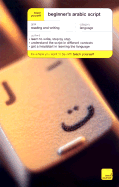 When I first decided to learn Arabic, I was very inhibited by the alphabet. Since I'd already studied Hebrew, I wasn't concerned about learning another alphabet, per se, just this particular alphabet. To my untrained eye, most Arabic words looked like they were made up of a long line of cursive lower-case letter i's without the dot – something like this:
When I first decided to learn Arabic, I was very inhibited by the alphabet. Since I'd already studied Hebrew, I wasn't concerned about learning another alphabet, per se, just this particular alphabet. To my untrained eye, most Arabic words looked like they were made up of a long line of cursive lower-case letter i's without the dot – something like this:  with a smattering of dots added later. Also, there seem to be an awful lot of letters. Luckily, both of these initial impressions were false. In reality, just like learning any new alphabet, it is just a matter of getting used to it and learning what to look for to distinguish between the different letters.
with a smattering of dots added later. Also, there seem to be an awful lot of letters. Luckily, both of these initial impressions were false. In reality, just like learning any new alphabet, it is just a matter of getting used to it and learning what to look for to distinguish between the different letters. If you flip through many of the books on learning to write Arabic, it appears that there are an awful lot of letters. In fact, there are only 28 letters, so this is only 2 more letters than we have in English and fewer than many European languages. Like English, each letter has several different forms. In English, we have uppercase and lowercase versions of each letter in both print and script. In Arabic, some, but not all, letters have different versions based on whether they are at the beginning, middle or end of a word. The good news is that the printed letters as you see them in books and handwriting are the same. (Calligraphy is a different story.) Usually, the differences only have to do with providing a way to link the letter to the surrounding letters while still keeping the essential features of the letter. For instance, the letter ب (Bah) is the second letter of the alphabet. At the beginning of a word, it usually looks like this ﺑ The second upstroke has been removed to leave a tail to connect to the next letter to the right. (Remember, Arabic is read from right to left.) In the middle of a word, it looks like this -
 (Note: this character is being displayed with an image because many browsers don't display this character as a free-standing letter.) At the end of the word, it looks like this - ﺐ Again, we have a tail to connect to the previous letter.
(Note: this character is being displayed with an image because many browsers don't display this character as a free-standing letter.) At the end of the word, it looks like this - ﺐ Again, we have a tail to connect to the previous letter.Arabic does have several sets of letters that look similar. The difference usually consists of the number and location of dots added to a basic form. For instance, the following letters:
All four very similar, except for the location of the dots, so keeping track of the dots is key.
By the way, these letters are baa (ب), which has a b sound. Taa (ت), which has a t sound. Thaa (ث), which has a th sound. Noon (ﻥ), which has an n sound.
Remember you didn't learn to read and write in your first alphabet in a day either! With study and practice, the Arabic alphabet will be as familiar as your first alphabet.



